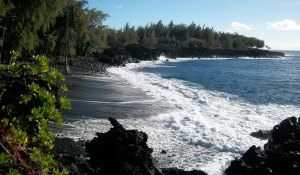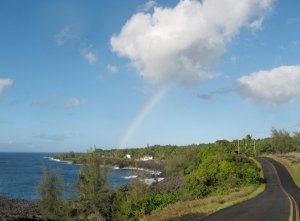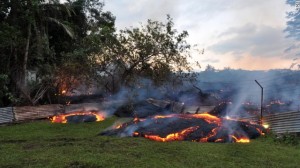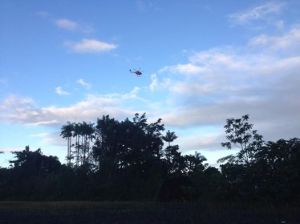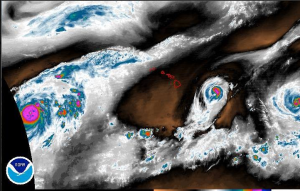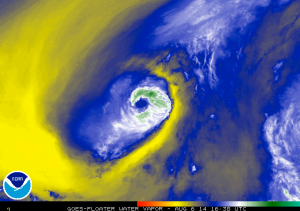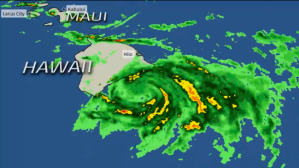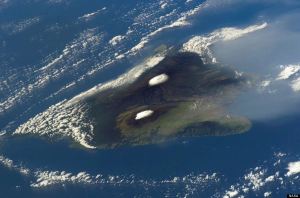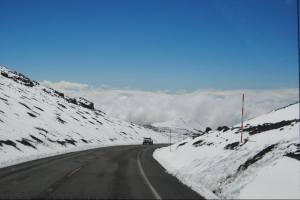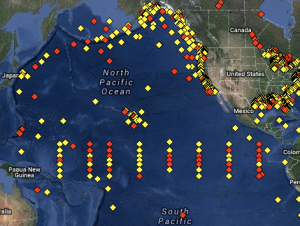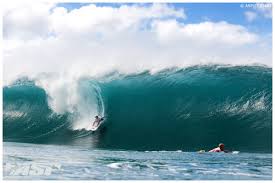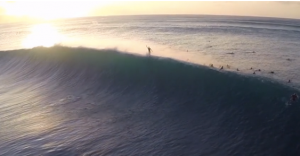Located on the Red Road, Rt. 137 along the lower Puna coast, Kehena Beach (also known as Dolphin Beach) is a prominent landmark for both local residents and visitors.
Its one of Hawaii’s Big Island “power spots” and for good reason as it is situated just down the coast from Kilauea and the lava flow of the Pu’u’O’o vent. The energy at Kehena Beach changes somewhat depending upon the crowd (or, the crowd is drawn there due to its fluctuating energy).
The ocean activity at this beach is as energetic as the people who frequent it. Brilliant blue waves crash against black lava rock and a beach of black sand inclines down into the water line creating a strong undertow and, in my opinion, a strong electromagnetic field. The entire beach is enclosed by a 30 foot high rock cliff and surrounded on both sides by rocky peninsulas jutting into the ocean, creating a cove, encapsulating this energy.
The beach itself is gorgeous with fine black sand amidst hosting several large rocks and boulders and a nice grove of ironwood trees. The hike down is NOT easy by any means but moderate on a scale of mild to difficult. A good sturdy pair of shoes is important as the trail descends through uneven rock. Near the bottom, round smooth rocks have sand on them making them deceivingly slippery, as well.
Ultimately, Kehena Beach is not for the faint of heart. In addition to the steep descent into it and the strong ocean and powerful current, it is a clothing optional beach and most people take advantage of the option. There is not a sense of taboo in this respect. In fact, the seclusion of the beach itself and the attitude of its visitors make it seem quite natural. People from all over the world gravitate to the natural energy hotspot. Whether local or tourists, they are not there to ogle one another, and are simply there to gather and visit or to swim.
There are no life guards at Kehena Beach and the waves are dangerous. Locals seem to have developed a technique for entering the ocean at the right pace, diving through the shoreline waves at just the right time to make it past the breakline which constantly changes. However, it’s possible to get pummeled in the wave breaks and rolled around like clothing in a washing machine.
Dolphins often frequent the waters off Kehena Beach. One of my first experiences after moving to this area nearly three years ago was spotting the dolphins while driving along Red Road. We came upon a rise just above the beach and saw the dolphins playing off shore. A woman with a long scarf swam out to meet them. A dolphin took the scarf she handed to them and they swam with it and exchanged it between them. It was a most surreal experience.
The morning crowd seems to be an older group. Some can be found doing tai chi or other forms of energy work. The morning sun is warm and welcoming and there is less chance to get burned. By 10am, the sun’s rays becomes hot and those who do not have a full body tan would be wise to cover up the parts that are not accustomed to being exposed to it.
The mid to late afternoon crowd encompasses folks of all ages. Children build sand castles while young people play like water sprites along the shoreline. Middle aged people swim with a child-like playfulness and older folks sit and chat with one another and greet old friends. Some bring instruments and drum or play flutes. It’s an interesting mix of the eclectic and mainstream, all of whom revel in the openness of the right to bear it all in a natural setting.
Sunday afternoons brings a crowd of regulars together to drum, sing and dance. It’s quite crowded at this time so if you are in the mood for a quiet, private experience, Sunday afternoon is not the optimal time to go. However, if you are in the mood for a group gathering, visiting Kehena Beach on a Sunday afternoon will be a unique experience to remember.
Kehena Beach sits unassumingly along the Red Road. There is no sign announcing its presence. A small unmaintained parking area, which the local community keeps quite clean, accommodates about 10-15 cars at most. Overflow parking is allowed along both sides of the road.
If you decide to make Kehena Beach a stop on your vacation remember to respect the land and the power of the ocean. People have died there and people have learned how to live life to its fullest there. There is no “in-between”. Last year the area lost a local icon, “Uncle” Manu. As it was told to me, at one point that day he said, “Today is a good day to die.” Later, he entered the ocean and drowned.
Interesting place, Kehena Beach. Visit it with abandon and play with caution.
Blog article about Uncle Manu
http://www.bigislandchronicle.com/?p=582
Article about strong current at Kehena Beach sweeping 6 people out to sea
Another blog about Kehena Beach
http://wanderwords.com/archives/2009/11/25/kehena-beach-big-island-hawaii
Free music downloads from Kehena Beach Sunday drum circle
http://www.facebook.com/pages/Pahoa-HI/Kehena-Beach-Drum-Circle-FREE-Music-DownLoads/62340791711
